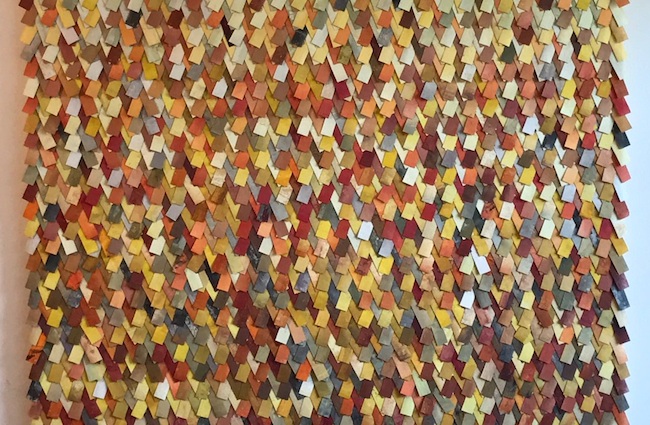Nel percorso di consolidamento e superamento compiuto dagli artisti contemporanei nei confronti dei movimenti del passato più recente, esistono alcuni creativi che, pur scegliendo di orientarsi verso una ben determinata corrente, preferiscono muoversi trasversalmente con un approccio sperimentale, attraverso il quale è possibile unire, fondere addirittura, le tecniche esecutive e l’intento concettuale, il pensiero nascosto oltre la forma. L’artista di cui vi parlerò oggi sceglie un tipo di linguaggio poliedrico da cui ciò che fuoriesce è l’importanza del significato in accordo tonale con le vibrazioni plastiche della materia.
L’incontro dell’espressione pittorica con la materia ha costituito un importante punto di svolta nell’arte del Novecento, in quella vivace fase in cui la rottura con il passato era già avvenuta e si doveva proseguire su quel terreno di sperimentazione attraverso il quale i creativi manifestavano la necessità di andare oltre la superficie bidimensionale della tela, ancora essenziale per le prime correnti avanguardiste dei primi anni del Ventesimo secolo come Espressionismo, Futurismo e Cubismo, e creare un dialogo più diretto e consistente tra opera e spazio esterno. Non solo, la ricerca su quanto una molteplicità di materiali di uso comune potesse cambiare veste e trasformarsi in opera d’arte interagendo direttamente con lo spazio circostante, indusse molti artisti a misurarsi con sfide affascinanti e sorprendenti dando vita a correnti in grado di segnare un punto di svolta sul modo di intendere l’arte. Lo Spazialismo, di cui fu massimo rappresentante Lucio Fontana, studiò l’interazione dello spazio all’interno della tela, un subentrare nell’opera come se fosse parte di essa attraverso l’incisione di tagli che introdussero anche il concetto del tempo, quello del gesto del taglio, come parte integrante del risultato finale; enfatizzato e modificato nell’esecuzione ma simile nell’intento espressivo fu l’Informale Materico di cui Alberto Burri fu grande esponente, in cui divenne essenziale l’utilizzo di materiali poveri, di scarto o di recupero da lavorazioni industriali come plastiche, sacchi di juta, legni, ferri che saldava, bruciava e scioglieva per infondere a quelle materie l’emozione del suo sentire, l’intensità di un’interazione tra interno ed esterno, tra ciò che è e ciò che si manifesta al di fuori. Il Dadaismo, il movimento dissacrante dell’anti-arte, usò a sua volta oggetti di uso comune per demistificare l’arte sottintendendo quanto chiunque potesse svegliarsi e decidere di trasformare qualsiasi cosa in forma espressiva definibile arte. Proseguendo nel corso del secolo l’Arte Povera, spogliandosi dell’intenzione derisoria e smitizzante del Dadaismo e riprendendo la linea tracciata dall’Informale Materico, tornò all’utilizzo di materiali di uso quotidiano come terra, legno, ferro, stracci, plastica, corde, tessuti e filati, scarti industriali, per rappresentare la società contemporanea e il suo linguaggio, riducendolo all’archetipo, all’essenzialità, per andare verso il concetto, come nel caso di Alighiero Boetti.
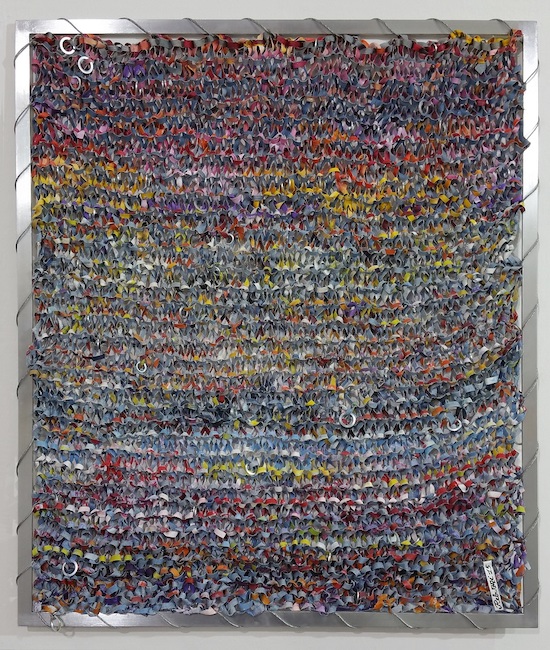
L’artista svizzera Daniela Rebuzzi, in arte Rebus, mescola la sperimentazione e l’utilizzo di materiali cosiddetti poveri, come ritagli di stoffe, tela, rafia, piume, per dar vita a opere in cui la bidimensionalità della tela fa da sfondo per un’interazione diretta con lo spazio circostante, un dialogo fisico tra intenzione concettuale e concretizzazione dell’emozione che a essa si lega; la sua creatività va oltre la sensazione e ha bisogno di essere accolta e razionalizzata prima di fuoriuscire sotto forma di colore, di rappresentazione solida di ciò che viene inizialmente intuito, perché l’ordinato caos che deriva dalla connessione tra mente e anima, tra istinto e ragione, diviene messaggio consapevole che in lei si manifesta dall’unione tra titolo, parte integrante dell’opera stessa, e colore.
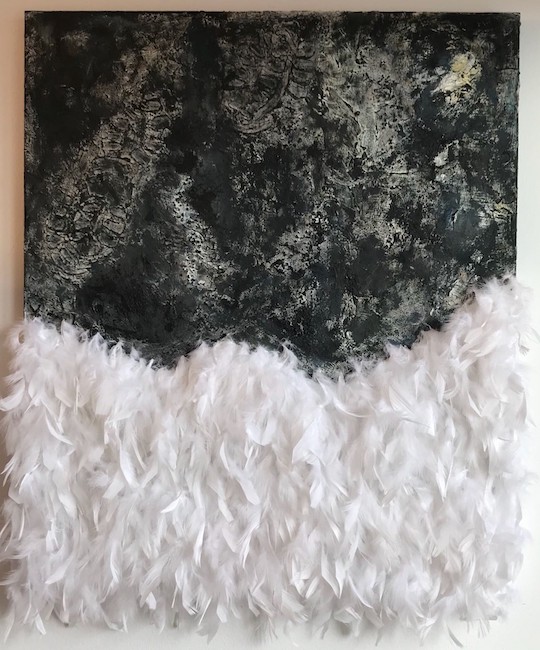
In alcune opere Daniela Rebuzzi si avvicina ai variopinti disegni murali della fase minimalista di Sol Lewitt, pur differenziandosene profondamente per l’utilizzo della materia dunque sebbene l’effetto visivo sia simile non lo è il mezzo per raggiungere quel risultato che nella Rebuzzi necessita l’incontro tattile con i materiali attraverso i quali la sua creatività riesce a esprimersi.
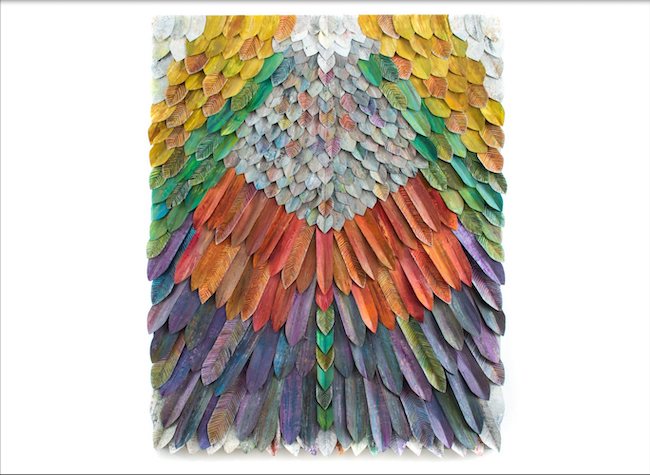
L’alternanza tra consistenza apparente e fragilità effettiva rivelata dalle strisce di tela ritagliata e poi ricomposta o dalle piume, sembrano essere metafora dell’essere umano che tende a costruirsi una rete di certezze più simili a castelli di carta che non a solide basi, o a una maschera, una corazza per proteggersi dall’esterno che spesso risulta inconsistente, utile solo a dare l’illusione di potersi nascondere per poi scoprire che con un solo soffio di vento più intenso, tutto possa essere sovvertito, scoperto, svelato malgrado l’illusione di essere protetti.
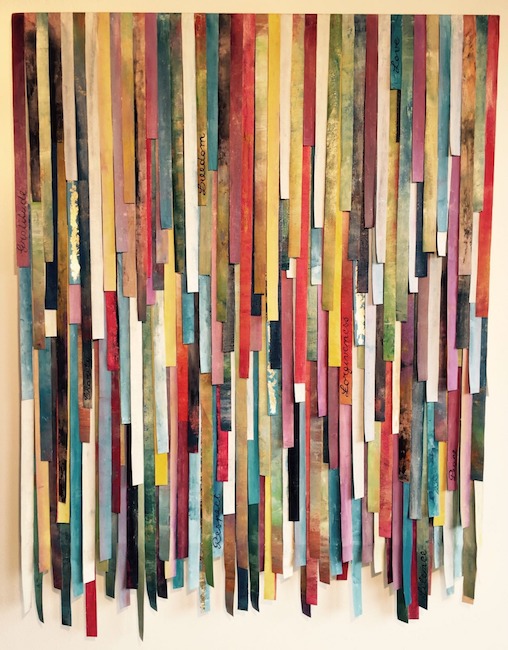
Nel lavoro Angels in the world la Rebuzzi racconta della molteplicità degli esseri umani, quella poliedricità di personalità, di caratteri e di individui che camminano fianco a fianco nella vita pur non conoscendosi affatto, affollano la società contemporanea inconsapevoli della loro interconnessione, arricchendola di colori che però spesso non riescono a essere intravisti; si cela un’analisi del vivere attuale in quest’opera, quella tendenza all’individualismo che induce le persone a rinchiudersi nel loro mondo interiore dimenticando di osservare ciò che avviene intorno essenziale per un’idea di comunità che, malgrado sia apparentemente dimenticata, resta importante per costruire quella rete di rapporti senza la quale l’essere umano non può che restare chiuso all’interno della propria solitudine.
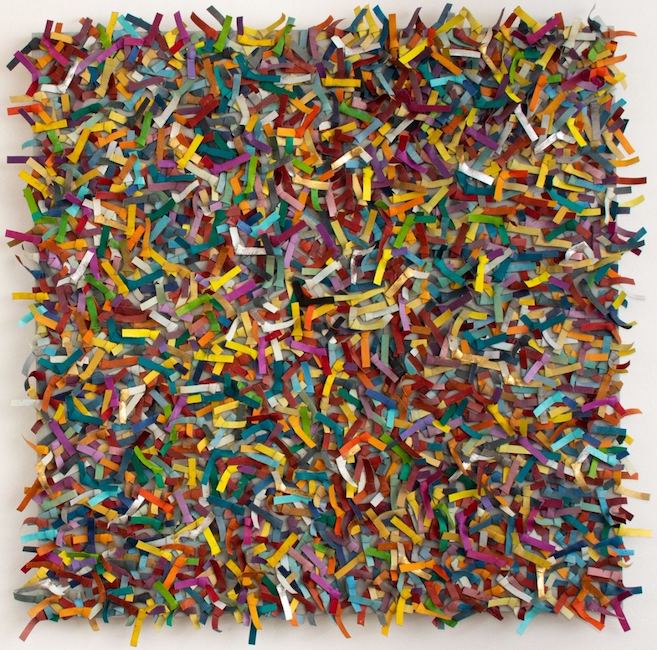
Ed è esattamente di quel reticolo fondamentale di legami umani che narra l’opera Soffio (tra gli irretimenti), una costante interazione con chi circonda l’esistenza e ne diviene parte, costituendo così un intreccio di punti di vista e di sostegno del quale l’uomo non può fare a meno, da cui non può prescindere perché di fatto costituisce la base del suo stesso vivere; se da un lato quelle interazioni possono infondere la sicurezza di sentirsi aiutati nel momento di bisogno e di difficoltà, dall’altro al contrario possono indurre l’individuo a sentirsi in trappola all’interno di quei legami, perché a volte generano un’immobilità, l’impossibilità di distaccarsene per percorrere il proprio cammino, per cercare un’autonomia priva di condizionamenti, di opinioni, di consigli che le persone più vicine sentono di dover esprimere. Ecco dunque che il soffio di cui parla il titolo, diviene impulso, o meglio desiderio, di libertà, suggerimento per trovare la forza di allontanarsi dai condizionamenti e di compiere in autonomia le scelte, decidendo il percorso da seguire.
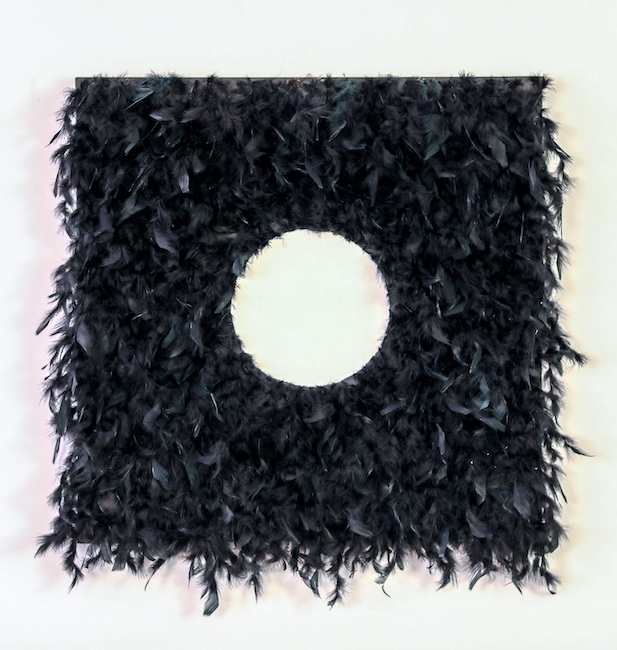
Nel lavoro Nell’invisibile la realtà Daniela Rebuzzi esplora il concetto della relatività dell’esistenza così come delle opinioni e del pensiero, perché spesso è proprio oltre il non detto, il non proclamato, il non visto che si nascondono verità troppo scomode per essere svelate, quelle dell’essere umano che non è capace di dialogare con se stesso, e quelle della società contemporanea che tende a mostrare solo la patina superficiale delle cose; l’alternanza tra spazio e materia, che riprende le linee guida dell’Arte Informale, costituisce la base per la riflessione dell’artista, laddove la materia ancora una volta sembra essere leggera, quasi effimera, perché le piume che la compongono possono essere sollevate con un semplice alito di vento, infondendo nell’osservatore la consapevolezza di quanto tutto ciò che viene utilizzato per coprirsi, per riempirsi di punti fermi, sia in realtà controvertibile da un’analisi più attenta e profonda.
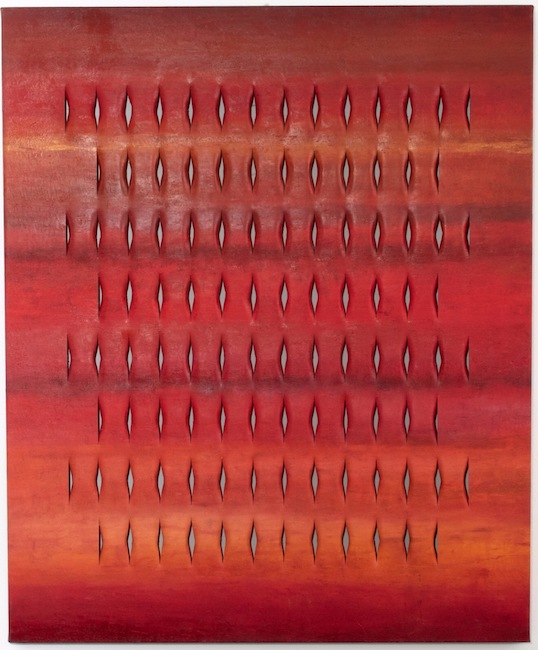
E infine, ne Gli sguardi del cuore, la Rebuzzi riprende le linee guida dello Spazialismo applicando tagli sulla tela che però nel suo caso sono ripetuti perché in fondo il cuore sa di non poter avere un punto di vista univoco, sa che le emozioni sono sfaccettate e molteplici e dunque l’interazione con la superficie bidimensionale non può che essere poliedrica, il dialogo con l’esterno amplificato proprio per l’incapacità dell’interiorità di soffermarsi su un solo dettaglio, a differenza della ragione che invece tende a fossilizzarsi su convinzioni che spesso si distaccano dalle sensazioni percepite. Daniela Rebuzzi, professionista del mondo finanziario, utilizza l’arte per conciliare le sue due anime, quella più razionale e pragmatica, e quella più morbida del mondo delle emozioni, delle riflessioni, degli interrogativi necessari per mettersi in discussione ed evolvere; ha al suo attivo numerose mostre collettive in Italia e all’estero, Francia, Gran Bretagna, Spagna, Emirati Arabi, Austria e Stati Uniti – Miami e New York – nelle quali ha riscosso grande successo di critica e di pubblico.
DANIELA REBUZZI-CONTATTI
Email: info@danielarebuzzi.ch
Sito web: www.danielarebuzzi.ch
Facebook: https://www.facebook.com/daniela.rebuzzi.7
Instagram: https://www.instagram.com/daniela_rebuzzi/
The multiple facets of matter in the artworks of Daniela Rebuzzi
In the process of consolidation and overcoming carried out by contemporary artists with respect to the movements of the more recent past, there are some creatives who, while choosing to orient themselves towards a specific current, prefer to move transversally with an experimental approach, through which it is possible to unite, even fuse, executive techniques and conceptual intent, the thought hidden beyond form. The artist I am going to talk about today chooses a multifaceted type of language from which what emerges is the importance of meaning in tonal accord with the plastic vibrations of matter.
The encounter of pictorial expression with matter constituted an important turning point in twentieth-century art, in that lively phase in which the break with the past had already occurred and it was necessary to continue on that terrain of experimentation through which creatives manifested the need to go beyond the two-dimensional surface of the canvas, still essential for the first avant-garde currents of the early twentieth century such as Expressionism, Futurism and Cubism, and create a more direct and consistent dialogue between the work and external space. Not only that, the research on how a variety of everyday materials could change their appearance and become a work of art by interacting directly with the surrounding space, led many artists to take on fascinating and surprising challenges, giving rise to currents that marked a turning point in the way art was understood. Spatialism, of which Lucio Fontana was the greatest exponent, studied the interaction of space within the canvas, a taking over of the artwork as if it were part of it through the incision of cuts that also introduced the concept of time, that of the gesture of cutting, as an integral part of the final result; emphasised and modified in its execution but similar in its expressive intent was the Materic Informal of which Alberto Burri was a great exponent, in which the use of poor, discarded or recycled materials from industrial processes such as plastics, jute sacks, wood and iron became essential, which he welded, burned and melted to infuse those materials with the emotion of his feeling, the intensity of an interaction between inside and outside, between what is and what is manifested outside.
Dadaism, the desecrating anti-art movement, also used everyday objects to demystify art by implying that anyone could wake up and decide to turn anything into an expressive form that could be defined as art. Continuing through the century, Arte Povera, shedding the derisive and demythologising intention of Dadaism and taking up the line traced by the Materic Informal, returned to the use of everyday materials such as earth, wood, iron, rags, plastic, ropes, fabrics and yarns, industrial waste, to represent contemporary society and its language, reducing it to the archetype, to essentiality, to move towards the concept, as in the case of Alighiero Boetti. Swiss artist Daniela Rebuzzi, aka Rebus, mixes experimentation and the use of so-called poor materials, such as scraps of fabric, canvas, raffia and feathers, to give life to artworks in which the two-dimensionality of the canvas acts as a backdrop for direct interaction with the surrounding space, a physical dialogue between conceptual intention and the concretisation of the emotion linked to it; her creativity goes beyond the sensation and needs to be accepted and rationalised before coming out in the form of colour, a solid representation of what is initially intuited, because the ordered chaos that derives from the connection between mind and soul, between instinct and reason, becomes a conscious message that in her is manifested by the union between title, an integral part of the artwork itself, and colour. In some of her artworks Daniela Rebuzzi comes close to the multicoloured wall drawings of Sol Lewitt’s minimalist phase, although she differs profoundly in her use of materials. Although the visual effect is similar, the means of achieving the result that Rebuzzi requires is a tactile encounter with the materials through which her creativity can express itself.
The alternation between apparent consistency and actual fragility revealed by the strips of canvas cut out and then reassembled, or by the feathers, seem to be a metaphor for the human being who tends to build a network of certainties more like paper castles than solid foundations, or a mask, an armour to protect oneself from the outside world that is often insubstantial, useful only to give the illusion of being able to hide, only to discover that with just one more intense gust of wind, everything can be subverted, discovered, revealed despite the illusion of being protected. In her artwork Angels in the World, Rebuzzi tells of the multiplicity of human beings, that multifacetedness of personalities, characters and individuals who walk side by side in life even though they do not know each other at all, crowding contemporary society unaware of their interconnection, enriching it with colours that often cannot be glimpsed; this artwork conceals an analysis of contemporary life, that tendency towards individualism which leads people to shut themselves up in their inner world, forgetting to observe what is going on around them. This is essential for an idea of community which, despite being apparently forgotten, remains important for building that network of relationships without which human beings can only remain closed within their own solitude. And it is precisely of that fundamental network of human ties that the artwork Soffio (tra gli irretimenti) (Breath, among the restlessness) narrates, a constant interaction with those who surround existence and become part of it, thus constituting an interweaving of points of view and support that man cannot do without, from which he cannot prescind because in fact it constitutes the basis of his very living; if, on the one hand, these interactions can instil the security of feeling helped in times of need and difficulty, on the other hand, they can induce the individual to feel trapped within those bonds, because sometimes they generate immobility, the impossibility of detaching oneself from them in order to follow one’s own path, to search for an autonomy free from conditioning, opinions, advice that the closest people feel they must express.
So the breath of which the title speaks becomes an impulse, or rather a desire for freedom, a suggestion to find the strength to move away from conditioning and to make independent choices, deciding which path to follow. In her artwork Nell’invisibile la realtà (In the Invisible Reality), Daniela Rebuzzi explores the concept of the relativity of existence as well as of opinions and thought, because it is often beyond the unspoken, the unproclaimed, the unseen that truths too uncomfortable to be revealed are hidden, those of the human being who is unable to dialogue with himself, and those of contemporary society which tends to show only the superficial veneer of things; the alternation between space and matter, which picks up on the guidelines of Informal Art, forms the basis for the artist’s reflection, where matter once again seems to be light, almost ephemeral, because the feathers that compose it can be lifted with a simple breath of wind, instilling in the observer the awareness of how much everything that is used to cover oneself, to fill oneself with fixed points, is in reality questionable by a more careful and profound analysis. And finally, in Gli sguardi del cuore (The looks of the heart), Rebuzzi takes up the guidelines of Spatialism by applying cuts to the canvas which, however, in her case, are repeated because after all the heart knows it cannot have a single point of view, it knows that emotions are multifaceted and multiple and therefore the interaction with the two-dimensional surface cannot but be multifaceted, the dialogue with the outside world is amplified precisely because of the inability of the inner self to dwell on a single detail, unlike reason, which tends to fossilise on beliefs that are often detached from perceived sensations. Daniela Rebuzzi, professionist in the financial world, uses art to reconcile her two souls, the more rational and pragmatic one, and the softer one of the world of emotions, reflections, and the questions necessary to question and evolve. She has had numerous group exhibitions in Italy and abroad, in France, Great Britain, Spain, the United Arab Emirates, Austria and the United States – Miami and New York – in which she met with great critical and public success.


